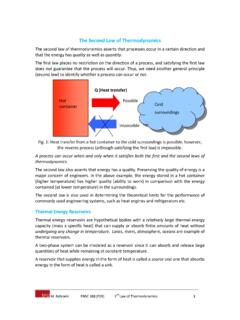K closed cycle refrigerator systems
Found 6 free book(s)UNIT 2 STEAM POWER PLANT Steam Power Plant - IGNOU
www.ignou.ac.inThe devices or systems used to produce a net power output are often called engines and the thermodynamics cycles they operate on are called power cycle. The devices or systems use to produce refrigeration are called refrigerator, air conditioners or heat pumps and the cycles they operates on are called refrigeration cycles.
Second Law of Thermodynamics
www.sfu.cathe cycle, even in idealized cycle. The Second Law: Kelvin‐Planck Statement It is impossible for any device that operates on a cycle to receive heat from a single reservoir and produce a net amount of work. In other words, no heat engine can have a thermal efficiency of 100%.
CLAUSIUS INEQUALITY AND ENTROPY
civil.colorado.eduk t q the ratio of the amount of heat transferred in a process to the temperature of the surroundings where heat is transferred calculating the ratio as the integral of a continuous function of t δq, clausius’ principle for a reversible or irreversible cycle is: 0 t q ∫ ⎟≤ ⎠ ⎞ ⎜ ⎝ ⎛δ (6) for reversible cycles: 0 t q 0 and t ...
Chapter 10: Refrigeration Cycles - Saylor Academy
resources.saylor.orgcycle. The refrigerant leaves the evaporator at -20oC and has a condenser pressure of 0.9 MPa. The mass flow rate is 3 kg/min. Find COPR and COPR, Carnot for the same Tmax and Tmin, and the tons of refrigeration. Using the Refrigerant-134a Tables, we have State Compressor inlet TC x h kJ kg s kJ kg K State Compressor exit PP kPa ss kJ kg K h kJ ...
REVIEW ON THERMOELECTRIC COOLING: MODELLING AND …
ijariie.comVol-4 Issue-1 2018 IJARIIE -ISSN(O) 2395 4396 7414 www.ijariie.com 784 REVIEW ON THERMOELECTRIC COOLING: MODELLING AND ITS APPLICATION Prof. Ajay Mendhe1, Mohit C. Dharmik2, Gaurav R. Pachare3, Utkarsh N. Borkar4, Vrushabh S. Mandre5, Bhushan S. Binorkar6, Vrushabh Shambharkar7 1 HOD, Department of Electrical Engineering, PJLCOE …
Introduction to Cryogenic Engineering - SLAC
www.slac.stanford.eduRefrigerants - data Refrigerant He3 He4 H 2 D 2 Ne N 2 CO F 2 Helium Helium Hydrogen Deuterium Neon Nitrogen Carbon Fluorine Monoxide Temperatures [K] liq liq 2-phase equilibrium at 10 mbar 0.97 1.67 11.4 15 18.1 53 57 58





